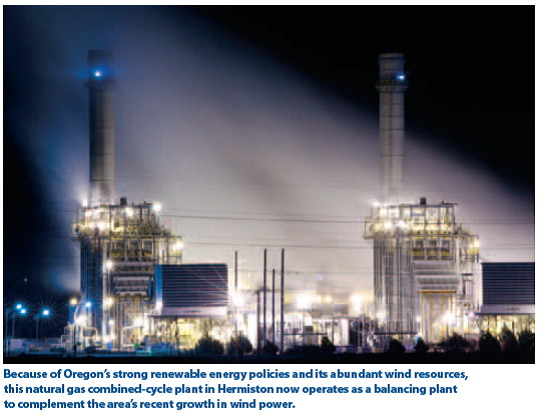The President’s Climate Plan announced in June touts natural gas as an important climate solution, as I discussed in a recent blog. This week the Environmental Protection Agency (EPA) is taking the first step in implementing one of the key components of his plan by re-issuing carbon standards for new power plants. The next and more important step in this process is for the EPA to issue draft carbon standards for existing power plants by June 2014. (For more details, see this blog by my colleague Rachel Cleetus).
While standards for existing plants will help reduce power sector carbon emissions, they could lead to an overreliance on natural gas if they are not designed in the right way. In addition, the U.S. will need to make much deeper cuts in emissions to limit some of the worst impacts of climate change, as I discussed in my blog in July. A new UCS report released today shows that a transition from a coal- to a natural gas-dominated electricity system would not be sufficient to meet U.S. climate goals. Instead, a diversified electricity system—with amplified roles for renewable energy and energy efficiency and a modest role for natural gas—would both limit the threat of climate change and mitigate the risks of an overdependence on natural gas.

The transition to natural gas is well underway
Coal’s share of U.S. electricity generation shrank from 48 percent in 2008 to 37 percent in 2012, while natural gas grew from 21 percent to more than 30 percent over the same period, according to data from the U.S. Energy Information Administration (EIA). The share of non-hydroelectric renewable energy has also nearly doubled over the same period to 5.4% in 2012. These changes are due to a combination of market and policy factors including low natural gas prices, the advanced age of many coal plants, the rising cost of coal, the need to upgrade pollution controls to protect public health, the falling cost of renewable energy, reduced growth in electricity demand, and state policies on renewable energy, efficiency, and climate.
The climate risks of natural gas
As with any fossil fuel, burning natural gas for electricity generation results in the release of CO2 and thus contributes to global warming. When combusted in a new, efficient, combined-cycle power plant, natural gas emits approximately 800 pounds of CO2 per megawatt-hour—some 50 to 60% lower than the heat-trapping emissions from a typical new coal plant. Nevertheless, natural gas plants are still far less attractive from a climate standpoint than cleaner and much lower-carbon alternatives such as energy efficiency and renewable energy.
The drilling and extraction of the fuel from wells, and its distribution in pipelines, also results in the leakage of methane—a much more potent greenhouse gas than carbon dioxide. Preliminary studies and field measurements have shown that methane leakage across the natural gas supply chain can range from 1-9% of total natural gas production. A new peer-reviewed study by the University of Austin-Texas that measured methane leakage at nearly 500 shale gas wells across the U.S. shows leakage rates at the lower end of the range for natural gas extraction.
While these results are encouraging, methane leakage still reduces natural gas’s climate advantages over coal while boosting the advantages that renewable energy and energy efficiency have over natural gas. And as our new report shows, even if we can reduce methane emissions to zero, natural gas is still a problem from a climate perspective because of its CO2 emissions.
An electricity future with greater use of natural gas use and increasing carbon emissions is clearly the wrong path for the United States

We reviewed the findings of four recent analyses—studies by the EIA, International Energy Agency (IEA), National Renewable Energy Laboratory (NREL), and UCS—that examined long-term effects on the U.S. power sector under various energy pathways. Each of these studies found that under current energy laws and regulations, U.S. natural gas generation would continue to increase over the next several decades—as much as tripling by 2050—to keep up with increasing electricity demand and to replace lost generation from retiring coal and nuclear plants (Figure 4).
Moreover, these four studies show that greater use of natural gas for generating electricity could contribute to an increase in power plant carbon dioxide emissions. Because of the continued dominance of fossil fuels and rising demand, emissions through 2050 would be 5 to 25% higher than today’s levels (Figure 5).

Achieving a low-carbon electricity future
To limit some of the worst consequences of climate change, the National Research Council (NRC) recommended an economy-wide carbon budget for the United States that would cut power sector carbon 90 percent from current levels by 2050 (Figure 5) as part of an economy-wide emissions reduction goal of greater than 80 percent by 2050.
The 2013 UCS report Water-Smart Power examined a reference scenario and three possible energy pathways that meet the NRC’s carbon budget. The study found that because of coal’s high carbon emissions, almost all existing coal generation (without CCS) is retired by 2030 under each of the pathways. It also found that while natural gas can play an intermediate role in temporarily replacing some of the decline in coal generation, its use must be scaled back considerably over the long term in order to meet climate goals (Figure 7).

Under a Renewables and Efficiency pathway much less natural gas generation is needed to meet electricity demand through 2026. In fact, natural gas generation is slightly below the Reference Case through 2020 before rising to its peak in 2028 under this pathway, and then steadily declines through 2050. The study also found that the Renewables and Efficiency pathway could save consumers money, while a Nuclear and CCS pathway would result in a 20 percent increase in consumer electricity bills by 2050.
Complementing the UCS analysis, the IEA and NREL studies also show that conventional natural gas is likely to play a limited role under a truly low-carbon electricity system. One IEA study found that increased global use of natural gas could lead to a long-term temperature increase of more than 6o F about pre-industrial levels — a level of warming associated with high risk of catastrophic environmental and economic consequences. An NREL study showed that under a renewable electricity scenario of 80% by 2050, natural gas generation would decline to 2.5% of U.S. electricity generation by 2050.
Is there an appropriate role for natural gas in a low carbon future?
While simply replacing coal with natural gas in the electricity sector would not be an effective long-term climate strategy, natural gas does offer some important advantages in the near to medium term. With sufficient regulatory oversight, burning natural gas instead of coal could help reduce air pollution, providing immediate public health and environmental benefits. And because natural gas generators can be ramped up and down quickly, they could support the integration of wind and solar, provide increased flexibility to the electricity system, and continue to be used to meet peak demand. Natural gas plants that generate both heat and power—which are up to twice as efficient as plants that only generate electricity—and plants that deploy carbon capture and storage technology could also play a role in reducing global warming emissions from natural gas.
Lawmakers and regulators have many opportunities to reduce the climate and other risks of using natural gas.
The 2013 UCS report offers several recommendations for reducing the risks of an overreliance on natural gas while building a more diversified electricity system, including:
- Finalizing and implementing strong EPA standards for carbon dioxide and other harmful emissions from new and existing power plants, while ensuring that renewable energy and energy efficiency can be used for compliance
- Adopting strong state and federal clean energy policies
- Strengthening regulations for hydraulic fracturing
- Incorporating the risks of an overreliance on natural gas into utility long-term planning
- Creating a level playing field for all low carbon technologies
